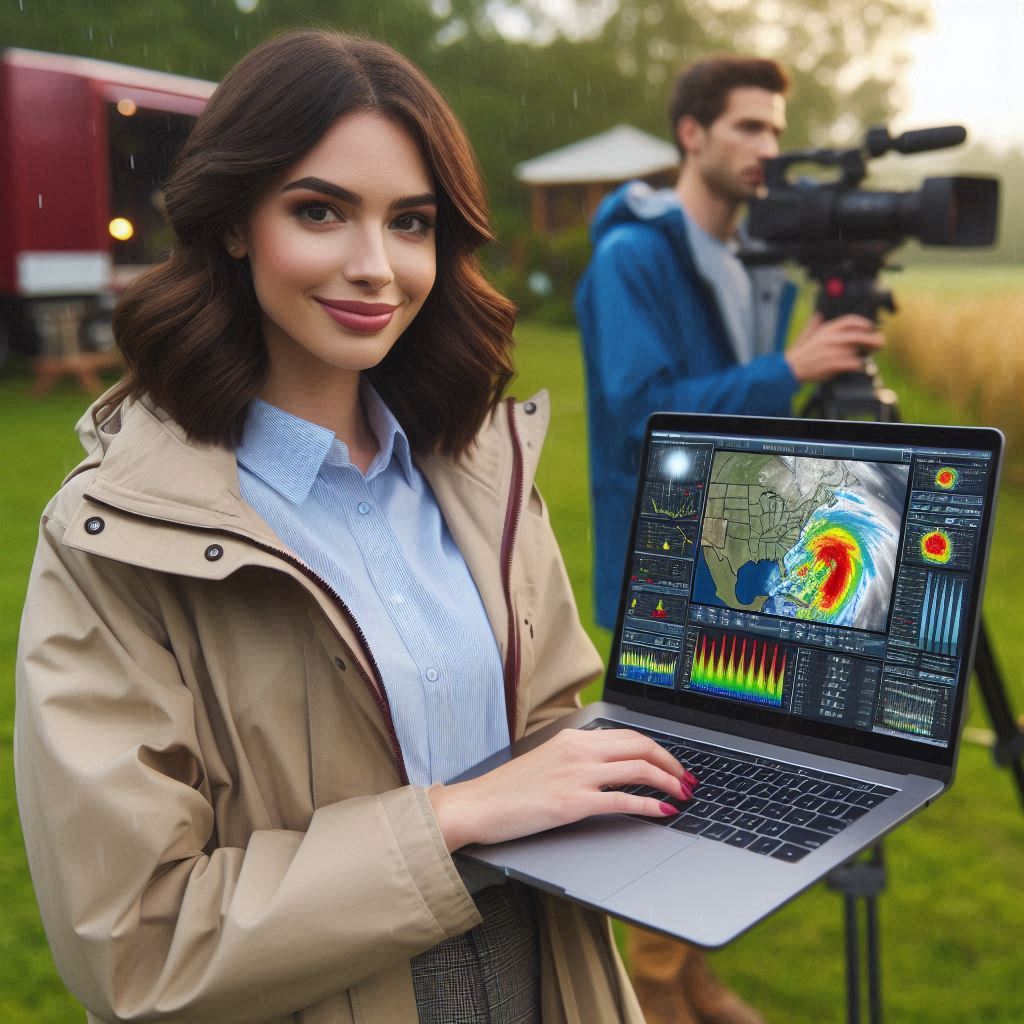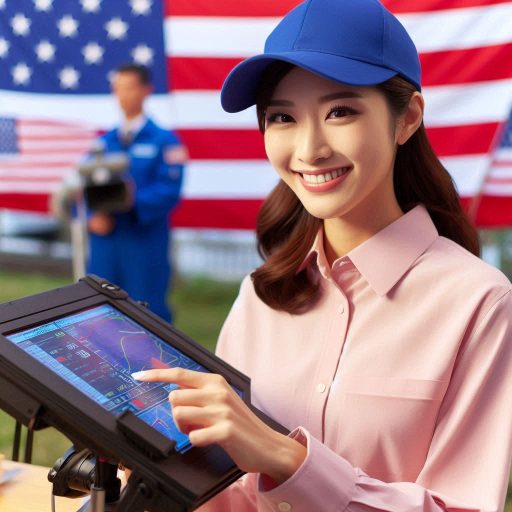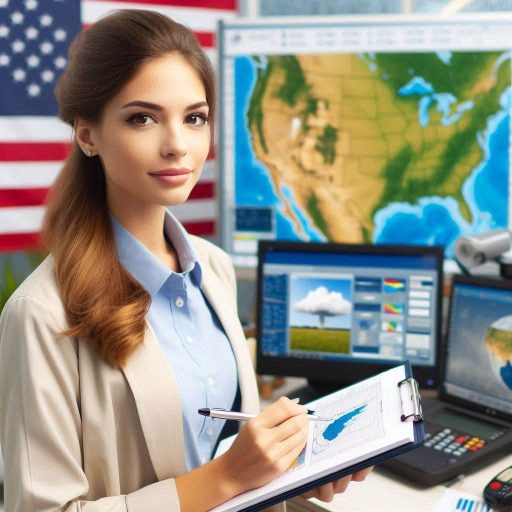Introduction
Meteorology studies the atmosphere and weather patterns, playing a crucial role in our daily lives.
Accurate weather forecasting helps communities prepare for natural disasters.
Women have increasingly contributed to this vital field, bringing unique perspectives and expertise.
Their involvement enriches meteorology, fostering innovation and diverse problem-solving approaches.
Despite historical challenges, women have made significant strides in meteorology.
They have broken barriers, demonstrating resilience and determination.
Many notable female meteorologists have paved the way for future generations, inspiring others to enter this field.
The importance of women in meteorology cannot be overstated.
Their contributions enhance our understanding of climate change, weather forecasting, and disaster preparedness.
As we explore women’s success in meteorology, we will highlight their achievements and the initiatives supporting their growth.
This blog will examine the history, current status, and future outlook for women in meteorology.
We will emphasize the significance of supporting women in breaking barriers and achieving success.
By recognizing and celebrating these accomplishments, we can foster a more inclusive and diverse meteorological community.
History of women in meteorology
Challenges Faced by Early Women Meteorologists
Women have faced significant challenges in meteorology throughout history.
Early women meteorologists encountered societal barriers and gender discrimination.
Many institutions excluded women from formal training and professional roles.
Despite these obstacles, some women persisted and paved the way for future generations.
In the early 20th century, few women entered the field.
Those who did often faced skepticism about their abilities.
Many had to prove themselves in a male-dominated environment.
Limited access to resources and mentorship hindered their professional growth.
Women struggled for recognition in a field that undervalued their contributions.
Pioneering Women in the Field
Despite these challenges, several pioneering women emerged in meteorology.
One notable figure is Dr. Agnes Meyer, who made significant contributions to meteorological science in the 1930s.
She was one of the first women to earn a doctorate in meteorology.
Her research on atmospheric pressure patterns laid important groundwork for future studies.
Another key pioneer is Dr. Joanne Simpson.
She became the first woman to receive a Ph.D. in meteorology in 1949.
Simpson’s work focused on tropical meteorology and cloud physics.
Her research significantly advanced our understanding of weather systems.
These women and others like them broke barriers and inspired future generations.
They demonstrated that women could excel in meteorological research and leadership roles.
Contributions to Meteorology by Women
Women have made countless contributions to meteorology over the years.
They have excelled in research, education, and public service roles.
For instance, Dr. Jennifer Francis has conducted vital research on Arctic climate change.
Her work has provided valuable insights into weather patterns and climate variability.
Women have also played crucial roles in weather forecasting and education.
Meteorologists like Dr. Marshall Shepherd have advocated for better public understanding of weather issues.
Shepherd’s efforts in outreach and education highlight the importance of effective communication in meteorology.
In recent years, the field has seen increased diversity and inclusion.
Many organizations actively support women in meteorology.
Initiatives like mentorship programs and scholarships help empower aspiring female meteorologists.
The contributions of women in meteorology continue to grow.
Their research informs public policy and enhances our understanding of climate change.
Women are breaking barriers and reshaping the field.
The history of women in meteorology is one of resilience and determination.
Despite facing numerous challenges, pioneering women have made significant contributions to the field.
Their efforts continue to inspire future generations of meteorologists, ensuring a more inclusive and diverse community.
As we recognize their achievements, we must continue to support and uplift women in meteorology.
Their impact is vital for understanding and addressing today’s pressing weather and climate issues.
Current Status of Women in Meteorology
Statistics on Gender Representation in the Field
The representation of women in meteorology has improved over the years.
According to recent statistics, women now make up about 30% of meteorologists.
This number reflects gradual progress in gender representation within the field.
However, women remain underrepresented in leadership and decision-making positions.
Only about 10% of women hold senior roles in meteorological organizations.
These statistics highlight the ongoing gender imbalance in the profession.
Progress Made Towards Gender Equality
Despite the challenges, significant progress has occurred in promoting gender equality in meteorology.
Many universities now support women in STEM fields, including meteorology.
These institutions offer scholarships and mentorship programs aimed at encouraging female students.
Additionally, professional organizations like the American Meteorological Society (AMS) advocate for women’s participation.
AMS has implemented initiatives to promote diversity and inclusivity within the field.
Conferences and networking events increasingly feature women speakers and leaders.
This visibility helps inspire young women considering a career in meteorology.
Successful female meteorologists now serve as role models, encouraging the next generation.
Programs that highlight women’s achievements foster a supportive environment for all.
Challenges Still Faced by Women in Meteorology
Despite progress, women in meteorology continue to face several challenges.
Gender bias and stereotypes persist in the workplace.
Many women report experiencing discrimination during hiring and promotion processes.
The lack of female mentors in senior positions further compounds this issue.
Work-life balance poses additional challenges for women in meteorology.
The demanding nature of the profession often conflicts with family responsibilities.
Many women struggle to navigate career advancement while managing personal obligations.
Women also encounter barriers to accessing resources and networking opportunities.
In male-dominated environments, women may feel isolated or overlooked.
This lack of support can hinder their professional development.
Additionally, the field of meteorology requires ongoing adaptation to new technologies.
Women may find it challenging to keep pace with rapidly evolving tools.
Training opportunities are essential for ensuring that all meteorologists stay current.
The current status of women in meteorology reflects both progress and ongoing challenges.
While the representation of women has improved, disparities remain.
The efforts of professional organizations and educational institutions are crucial in fostering gender equality.
By addressing barriers and promoting inclusive practices, the meteorology community can create a supportive environment for all.
Encouraging diversity in leadership and decision-making positions is essential for the field’s growth.
As women continue to break barriers in meteorology, their contributions will shape the future of weather science.
Read: What Does a Geologist Do? Career Overview and Insights
Breaking barriers in meteorology
Examples of Women Overcoming Obstacles in the Field
Many women have broken barriers in meteorology, demonstrating resilience and determination.
Dr. Judith Curry is a notable example.
She faced skepticism in her research on climate change.
Despite challenges, she became a respected voice in meteorology.
Her work has influenced climate policy discussions and educational initiatives.
Another inspiring figure is Dr. Ellen Bassett.
She successfully navigated a male-dominated environment to become a leading researcher.
Dr. Bassett has contributed significantly to understanding severe weather patterns.
Her achievements highlight the importance of perseverance in overcoming obstacles.
Similarly, meteorologist Angela Fritz has gained recognition for her engaging communication style.
She excels at translating complex weather data for the public.
Fritz’s work demonstrates the power of effective communication in the field.
Her success inspires other women to pursue careers in meteorology.
Initiatives Supporting Women in Meteorology
Various initiatives support women breaking barriers in meteorology.
Organizations like the American Meteorological Society (AMS) promote diversity and inclusion.
AMS offers mentorship programs to connect experienced meteorologists with young women.
These programs provide valuable guidance and networking opportunities.
Another initiative, the Women in Atmospheric Sciences (WAS) group, focuses on empowering women in meteorology.
WAS organizes workshops, conferences, and events that foster professional development.
These platforms enable women to share experiences and learn from each other.
Educational institutions also play a critical role in supporting women.
Many universities now offer scholarships specifically for female students in meteorology.
These scholarships help reduce financial barriers and encourage more women to enter the field.
Impact of Breaking Barriers on the Field as a Whole
Breaking barriers in meteorology has a profound impact on the field.
Increased diversity leads to a wider range of perspectives and ideas.
This diversity enhances the quality of research and innovation in meteorology.
Women bring unique insights that improve weather forecasting and analysis.
Furthermore, successful women in meteorology serve as role models.
Their achievements inspire future generations of female meteorologists.
Young girls now see a path forward in this traditionally male-dominated field.
This inspiration helps cultivate interest in meteorology among diverse populations.
The rise of women in meteorology also contributes to better public trust.
When women leaders engage with communities, they foster relationships built on credibility.
Diverse teams are better equipped to address community needs and concerns.
This engagement enhances the overall effectiveness of meteorological services.
Women are breaking barriers in meteorology through determination, support, and resilience.
Their successes inspire others and contribute to the advancement of the field.
By fostering inclusivity and supporting initiatives, the meteorology community can continue to thrive.
As women continue to rise in this profession, they will shape the future of meteorology for the better.
Read: Educational Path: Becoming a Geologist in the USA
Women’s success stories in meteorology
Profiles of Notable Women Meteorologists
Several women have made significant contributions to meteorology, paving the way for future generations.
One notable figure is Dr. Laura Furgione.
She served as the Deputy Director of the National Weather Service (NWS).
Dr. Furgione played a crucial role in enhancing weather services.
Her leadership inspired many women to pursue careers in meteorology.
Another remarkable meteorologist is Dr. Jennifer Francis.
She specializes in climate change and its effects on weather patterns.
Dr. Francis’s research has gained international recognition.
Her insights help inform public policy and climate initiatives, showcasing women’s critical roles in science.
Meteorologist and author Dr. Christine McEntee also stands out in the field.
As the former Executive Director of the American Geophysical Union, she advocated for diversity in Earth sciences.
Her work emphasizes the importance of including women in meteorology.
Achievements and Advancements Made by Women in the Field
Women have achieved significant advancements in meteorology over the years.
In 2019, Dr. Marshall Shepherd received the prestigious AMS Fellow designation.
This honor recognized his outstanding contributions to atmospheric sciences, demonstrating the impact of mentorship on women’s success.
Moreover, the number of women earning degrees in meteorology has steadily increased.
More universities now offer programs that encourage female students.
This growth has led to a more diverse workforce in meteorology, enriching the field with varied perspectives.
Additionally, women have taken on leadership roles in major meteorological organizations.
They influence policies and promote best practices in weather forecasting.
Their leadership continues to inspire younger generations of women in science.
Inspirational Stories of Women Overcoming Challenges and Succeeding in Meteorology
Many women in meteorology have faced significant challenges yet triumphed in their careers.
One inspiring story is that of Dr. Carla P. Jones.
As a minority woman in meteorology, Dr. Jones encountered skepticism throughout her education.
Despite these obstacles, she earned a PhD and became a leading researcher in tropical meteorology.
Meteorologist Marissa Rhea also shares her success story.
She started her career as an intern and faced numerous rejections.
Rhea persevered, eventually securing a position with a major weather network.
Her journey exemplifies resilience and determination in overcoming barriers.
Another remarkable tale is that of meteorologist Aisha A. El-Amin.
She overcame cultural barriers and discrimination in her path.
Aisha now serves as a role model for young women interested in science.
Her story highlights the importance of representation in meteorology.
Women in meteorology continue to break barriers and achieve remarkable success.
Their accomplishments inspire future generations and advance the field.
By recognizing and celebrating these stories, we can encourage more women to enter meteorology and contribute to this vital discipline.
Read: Botany Career Fairs and Networking Events

Importance of diversity in meteorology
Benefits of Gender Diversity in the Field
Gender diversity in meteorology offers numerous benefits.
Diverse teams enhance creativity and innovation in research and problem-solving.
Women bring different experiences and viewpoints, enriching discussions.
This diversity leads to improved weather forecasts and public safety strategies.
Studies show that diverse groups make better decisions, especially during crises.
Additionally, gender diversity helps attract a broader talent pool.
When women see others succeeding in meteorology, they feel encouraged to pursue careers.
A diverse workforce enhances collaboration and teamwork, driving success in projects.
Ultimately, this diversity leads to a more resilient and effective meteorological community.
How Women Bring Unique Perspectives to Meteorology
Women contribute unique perspectives in meteorology, shaping how the field evolves.
They often approach problems differently, focusing on collaboration and community engagement.
Women’s experiences can highlight the impacts of weather events on different populations.
This understanding fosters more inclusive research and outreach programs.
Moreover, women are increasingly taking on leadership roles within meteorological organizations.
Their presence in decision-making positions ensures diverse viewpoints influence policies.
This diversity helps organizations address the needs of various communities effectively.
Women’s involvement in mentoring programs also supports younger female meteorologists, ensuring a continuous pipeline of talent.
Strategies for Promoting Diversity and Inclusion in Meteorology
Promoting diversity and inclusion in meteorology requires intentional strategies.
First, educational institutions must encourage women to pursue meteorology degrees.
Outreach programs in schools can spark interest among young girls.
Scholarships and mentorship initiatives can also support female students in their studies.
Meteorological organizations should implement diversity training programs.
These programs can educate staff about unconscious biases and promote inclusive practices.
Creating a supportive work environment is crucial for retaining female employees.
Organizations can offer flexible work arrangements to accommodate diverse needs.
Networking opportunities can also help women advance in meteorology.
Establishing organizations that focus on women in meteorology creates connections and support.
Conferences and workshops can provide valuable networking experiences for women.
Additionally, recognizing and celebrating the achievements of women in the field encourages further progress.
Promoting diversity in meteorology is essential for innovation and progress.
Gender diversity brings unique perspectives and enhances decision-making processes.
By implementing effective strategies, we can create a more inclusive environment for women in meteorology.
This commitment will strengthen the field and ensure a brighter future for all.
Read: Preparing for a Botany PhD: Tips and Advice
Transform Your Career Today
Unlock a personalized career strategy that drives real results. Get tailored advice and a roadmap designed just for you.
Start NowOpportunities for Women in Meteorology
Career Paths Available in Meteorology
Meteorology offers various career paths for women.
These include roles in research, forecasting, and education.
Women can work as operational meteorologists, providing weather forecasts for the public and industries.
Some women pursue careers in climate science, studying long-term weather patterns and climate change impacts.
Others may choose to work in broadcasting, delivering weather reports to the public.
This role allows women to engage with the community and raise awareness about severe weather.
Women can also explore careers in private industry.
Companies hire meteorologists to provide expertise for agriculture, energy, and transportation sectors.
Consulting firms often seek meteorologists to analyze weather data and provide insights to clients.
Women can also venture into academia, conducting research and teaching future meteorologists.
Scholarship and Mentorship Programs for Women in the Field
Numerous scholarship programs support women pursuing meteorology degrees.
Organizations such as the American Meteorological Society (AMS) and the National Weather Association (NWA) offer scholarships specifically for women.
These programs help alleviate financial burdens and encourage more women to enter the field.
Mentorship programs also play a crucial role in supporting women in meteorology.
Experienced meteorologists can guide younger women, providing insights and advice.
These relationships help women navigate challenges and build confidence in their careers.
Programs like the AMS Mentorship Program connect women with established professionals.
Networking events and conferences provide additional support.
Women can connect with peers and learn about job opportunities and advancements.
This networking fosters a sense of community and encourages collaboration among women in the field.
Resources for Women Seeking to Enter or Advance in Meteorology
Various resources are available for women interested in meteorology.
Online platforms and organizations provide valuable information about careers in meteorology.
Websites like “Women in Atmospheric Sciences” and “Women in Meteorology” offer resources for education and career development.
Professional organizations also host workshops and training sessions.
These events enhance skills and knowledge in meteorology.
Participants can learn about the latest technologies and research in the field.
Online courses and webinars can provide further education and specialization opportunities.
Social media platforms create communities for women in meteorology.
Women can share experiences, seek advice, and find job leads through these networks.
Active online groups and forums foster discussions on challenges and successes.
Women in meteorology have numerous opportunities for growth and success.
Diverse career paths, scholarships, and mentorship programs support women’s journeys in this field.
By leveraging available resources, women can advance their careers and contribute significantly to meteorology.
Future Outlook for Women in Meteorology
Trends in Gender Equality in the Field
The landscape for women in meteorology is gradually changing.
Increasing awareness of gender inequality has led to initiatives promoting female representation.
More women are enrolling in meteorology programs at universities.
Recent statistics show a rise in female graduates entering the field.
Professional organizations actively work to support women’s advancement in meteorology.
These groups focus on providing networking opportunities and mentorship programs.
Media representation of women in meteorology is also improving.
News outlets highlight female meteorologists in prominent roles.
This visibility inspires future generations of women pursuing careers in meteorology.
Universities and institutions are increasingly recognizing the importance of diversity.
They implement policies to encourage female students and faculty in meteorology programs.
Potential for Further Progress and Advancements
The potential for further progress in meteorology is significant.
Organizations are creating initiatives aimed at promoting gender equality.
These initiatives focus on equitable hiring practices and workplace inclusivity.
Companies are beginning to prioritize diversity in their hiring processes.
This commitment helps to ensure that women have equal opportunities for advancement.
Emerging technologies also present new avenues for women.
Data science and machine learning are transforming meteorology.
Women can excel in these areas, enhancing their skills and career prospects.
As the field evolves, women can take on more leadership roles.
This evolution fosters a culture of innovation and inclusivity.
Challenges That Still Need to Be Addressed for Women in Meteorology
Despite progress, challenges remain for women in meteorology.
Gender biases still exist within the field.
Women often face skepticism about their expertise and capabilities.
This skepticism can hinder career advancement and lead to a lack of support.
Work-life balance continues to be a concern for many women.
The demanding nature of meteorology can conflict with family responsibilities.
Employers must provide flexible working arrangements to support female meteorologists.
Addressing these challenges is essential for retaining women in the field.
Additionally, women in meteorology often lack representation in leadership roles.
This underrepresentation limits the perspectives and ideas shaping the field.
Organizations must prioritize mentoring and promoting women to leadership positions.
The future outlook for women in meteorology is promising.
Trends indicate progress toward gender equality, with increased female representation.
However, significant challenges remain, necessitating ongoing efforts for improvement.
By addressing these issues, the meteorology field can become more inclusive, benefiting all professionals involved.
Conclusion
Women in meteorology significantly impact the field through their contributions and unique perspectives.
Their involvement drives innovation and enhances weather forecasting.
However, challenges like gender biases and limited leadership opportunities still exist.
Addressing these issues requires collective efforts from institutions, employers, and professional organizations.
Mentorship programs and scholarships empower women and ensure their success in meteorology.
Promoting equitable hiring practices also fosters an inclusive environment.
The field can greatly benefit from diverse ideas and approaches.
Recognizing and celebrating the achievements of women in meteorology is essential for progress.
The future of meteorology relies on breaking barriers and creating more opportunities for women.
Support from all levels can enhance representation and foster growth.
Engaging women in leadership roles strengthens the entire field.
It is crucial to continue advocating for women’s empowerment in meteorology.
As we move forward, let’s work together to build a more inclusive and equitable field.
Together, we can ensure that women’s voices and contributions are valued.
A brighter future for women in meteorology will ultimately lead to better outcomes for everyone.
Let’s support and uplift women in meteorology for lasting change.
[E-Books for Sale]
The Big Book of 500 High-Paying Jobs in America: Unlock Your Earning Potential
$19.99 • 500 High-Paying Jobs • 330 pages
Explore 500 high-paying jobs in America and learn how to boost your career, earn more, and achieve success!
See All 500 High-Paying Jobs of this E-Book
1001 Professions Without a Degree: High-Paying American Jobs You Can Start Now
$19.99 • 1001 Professions Without a Degree • 174 pages
Discover 1001 high-paying jobs without a degree! Unlock career tips, skills, and success strategies for just $19.99!




